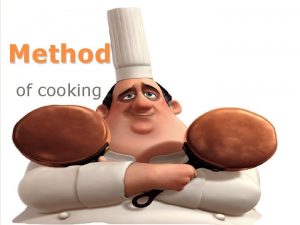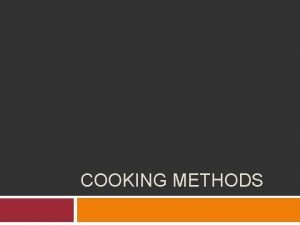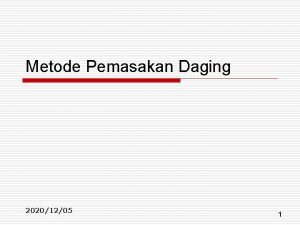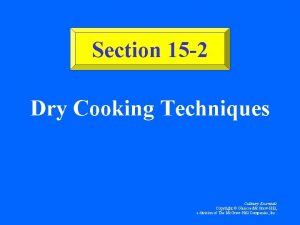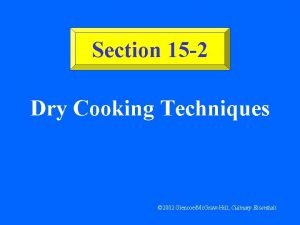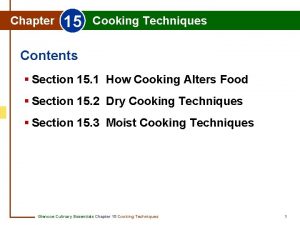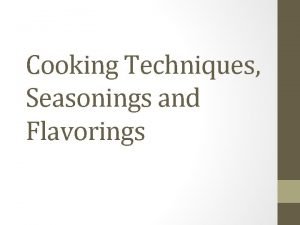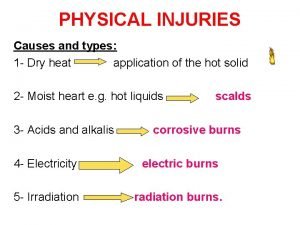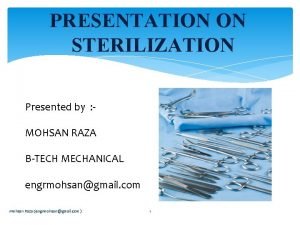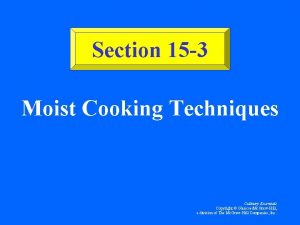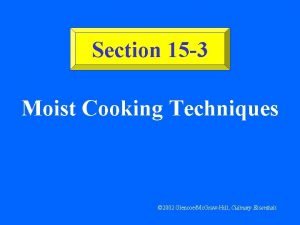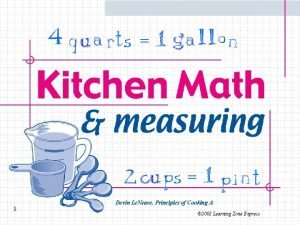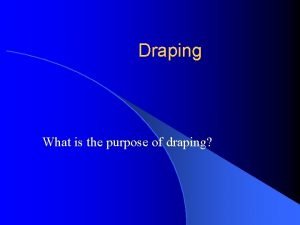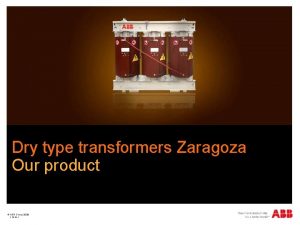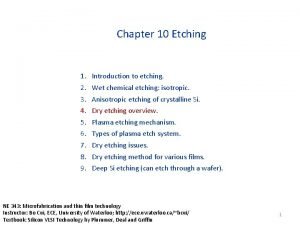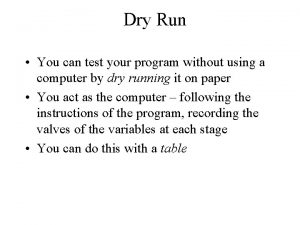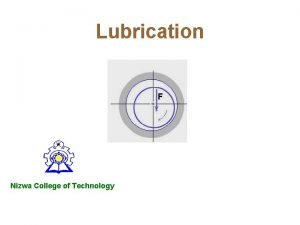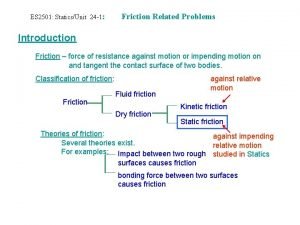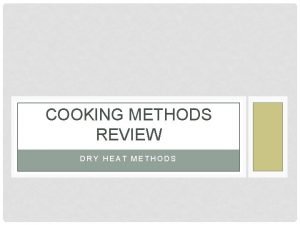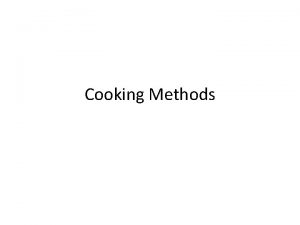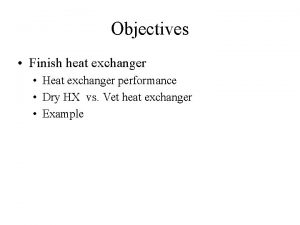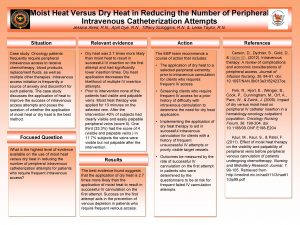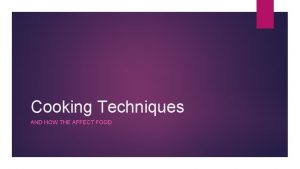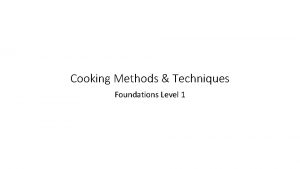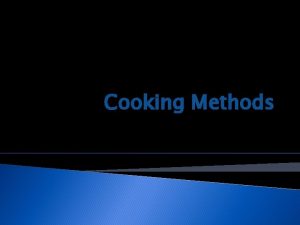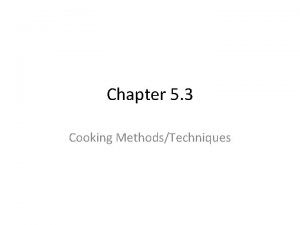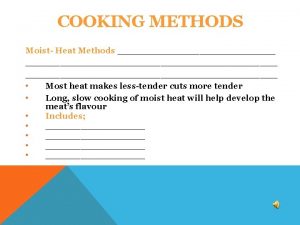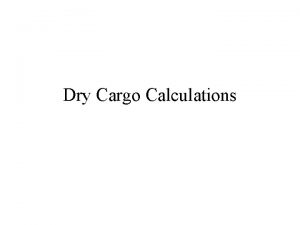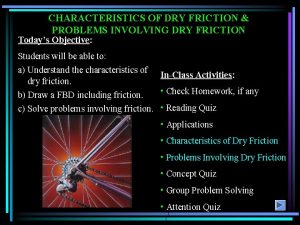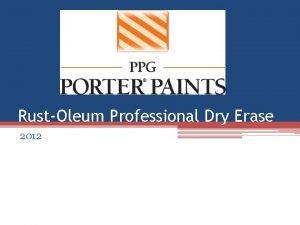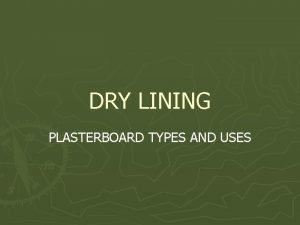Dry Heat Cooking Techniques What is Cooking Cooking


























- Slides: 26

Dry Heat Cooking Techniques

What is Cooking? �Cooking is producing safe, palatable, tasteful, digestible food by using heat energy. �Cooking affects the nutritive value, texture, color, aroma, and flavor of food.

Cooking transfers energy from a heat source to food. Three methods of heat transfer: Conduction – Direct contact or adjacent cooking, Ex> range top cooking like sautéing or grilling Convection – Mechanical movement of heat using a fan inside the oven, like baking or roasting Radiation – Infrared or Microwave energy

Effects of Heat on Food �FATS (oil, butter, shortening, lard) Melt and break down when heated �CARBOHYDRATES Sugars – Caramelize (browning effect) Starches – Gelatinize (thickening effect) �PROTEIN Coagulation – (liquid to a solid, ex. Raw eggs to scrambled eggs)

Why does cooked food go brown? All foods - meat, fish, and vegetables - brown at temperatures above 300°F. This is known as the 'Maillard Reaction'. It generates the characteristic color and aroma of foods cooked over a flame, in the oven, or in oil. The Maillard reaction was discovered in 1912 by the French chemist Louis Camille Maillard. It happens when sugar molecules and amino acids (a chemical found in proteins) are heated together. The reaction produces a bunch of highly flavored molecules responsible for the brown color, smell and taste of cooked meat. But not all cooked food goes brown. When you boil something in water, the temperature of the food never exceeds the boiling point of water (212°F). So it doesn't get hot enough for the Maillard Reaction to happen. However, deep-fried food does go brown because oil boils at over 300°C.

3 Types of COOKING METHODS �Cooking methods can be classified as to the amount of moisture used in the process. n. Dry Heat Cooking n. Moist Heat Cooking n. Combination Cooking

Cooking Techniques DRY Moist • Grill/Broil • Poach • Bake/Roast • Simmer • Sauté • Boil • Pan Fry • Steam • Deep Fry Combination • Braise • Stew

Cooking Techniques Dry Cooking Method - Air Dry Cooking Method - Fat Moist Cooking Method Combination Cooking Roast Sauté (& Searing) Poach (160 -185°F ) Braise Bake Stir Fry Simmer (185 -200°F) Stew Grill Shallow Fry Boil (& Blanch) (212°F) Broil Deep Fry Steam (212°F+)

Baking �Cooking with dry heat in a closed environment resulting in little perceptible fat or moisture �Advantages n usually used for breads, pastries, casseroles and portioned items n provides less intense heat source than direct heat n can free-up range space for other cooking

Roasting �Dry heat in a closed environment or on a spit over an open fire �Used for large tender cuts of meat �Low temperature roasting (less than 400°F) is often best because of: more even cooking n more moisture retained n better yield (less shrinkage) n

Roasting �Product is tied or trussed to compact shape and promote uniform cooking. �Product is elevated so it won’t fry in it’s own rendered fat �Product may be basted to create a crisp skin or lard/bard �Most accurate assessment of doneness is by internal temperature �Drippings are used to make gravy

BASTING �A process by which rendered fat is periodically applied to a roast during the cooking process. �This process helps to crisp the outer surface of the product. �Can also be accomplished by barding (wrapping meat in a layer of fat (like bacon) before cooking). �Some products self-baste by their natural design (i. e. a standing rib roast/ prime rib)

Open-Spit Roasting �Food is placed on metal rod or long skewer and slowly turned over a source of heat. �Drip pan is place under the product to catch all liquid.

Dry Heating Cooking With Oil � Sauté “To jump” Minimal oil, hot pan, controlled heat of medium/high � Deep Fry Deep fry- 350° to 375°F ▪ Completely submerged in oil Shallow Fry (also called Pan-Fry) ▪ Not completely submerged ▪ Covered in oil by 1/2 to 3/4

SHALLOW-FRYING �Also called pan-frying. �To cook in a moderate amount of fat over moderate heat. �Product is covered at least half way in hot fat and turned once during the cooking process. �Fat should be strained between each use.

Deep-Fry � Conduction / Convection Transfer of Heat � Product is completely submerged in heated fat or oil. Maintained at 350°F to 375°F. � Outside of product is sealed on contact. � High heat of fat accelerates the internal temperature, natural moisture of product steams, thus cooking product. � Batter or other coating is used to protect outside of food product.

Cooking Oils Generally speaking, the higher the degree of fat saturation, the higher the smoking point and therefore the more suitable the fat for high heat cookery. • Types of cooking oils • Whirl (liquid vegetable oil with butter flavoring) • Clarified butter (or Ghee; separating out the milk solids) • Salad oil (Olive, Vegetable, Sesame, Corn or Safflower) • Partially hydrogenated vegetable oils (shortening) • Frying shortening • Olive oil (Not Extra Virgin)

What does the “Smoke Point” mean? * It is the chemical breakdown of fat when it is overheated * The glycerol molecules break down and turn into an acid irritant known as acrolein. * Acrolein is a sharp, acrid product that is irritating to the eyes, nose, and throat. * It tends to ruin the flavor of the food being cooked in it. * The product will actually absorb fat because the oil temp can no longer be maintained. * The smoke point of an oil lowers each time it is used because some deterioration is inevitable.

Smoke Points of Various Fats Canola Oil Safflower Soybean Corn Blended Vegetable Peanut, Sunflower Olive Lard Shortening Clarified Butter Whole Butter 510 F 495 F 475 F 450 F 440 F 420 F 375 F + 370 F + 330 F 250 F 510 F

Sautéing �Literally means ‘to jump” in French �Defined as cooking with a minimum amount of fat or oil over medium/high heat. �May involve rapid movement of the food. �Is best to use fat with a high smoke point. �Procedure: Preheat pan, add oil. When near smoke point, add product. If Oil is too cold, product absorbs fat, affecting the flavor.

SEARING �Using high heat to change a product’s outside, done with flour or a dry crumb: Taste- caramelizes Texture-creates a crust on the outside Appearance -Maillard reaction (browning)

DREDGING �To dredge means to coat a food product with flour (or finely ground crumbs). �Often, sautéed or seared items are dredged first before cooking. �This coating absorbs surface moisture and helps brown the food. �Used especially with white meats like chicken. Ex. Fried Chicken or Parmesan Chicken

DEGLAZING � Means to swirl or stir a liquid (usually wine or stock) in a pan to dissolve cooked food particles (FOND) remaining on the bottom of the pan. � In other words, it is the process by which food particles and natural drippings from the cooking of food are loosened from the cooking vessel. � This is done by adding liquid to the hot pan and scraping while simmering at a lower temperature. � The resulting mixture often becomes the base for a sauce and is a critical step in producing good gravies.

Grilling & Broiling �Both methods are DRY heat cooking methods that use conduction and radiant heat transfer, and are used for portioned products. �Grilling is “underfired”, has heat from below. Griddles are flat surfaced grills �Broiling is “overfired”, has heat from above. “Salamanders” are small broilers

Grilling � To cook something over a frame of metal bars, usually using gas or charcoal. �Heat ranges from 250 -650 F �Metal frame/grates must be oiled after preheating before the placement of food product to prevent sticking. �Do NOT use cooking spray on a hot grill!!

To Broil �Radiation / Conduction Transfer of Heat. �Dry Cooking Method. Heat source from above, 500°F, Electric or Gas Heat source. �Adequate pre-heating is important.
 Moist heat cooking definition
Moist heat cooking definition Dry heat methods
Dry heat methods Is microwaving a dry heat method
Is microwaving a dry heat method Metode pemasakan
Metode pemasakan Section 15-2 dry cooking techniques
Section 15-2 dry cooking techniques Section 15-2 dry cooking techniques
Section 15-2 dry cooking techniques Simmer definition food
Simmer definition food Dry method of cooking
Dry method of cooking Injury caused by dry heat
Injury caused by dry heat Sterilization by mechanical method
Sterilization by mechanical method O heat dry up my brains
O heat dry up my brains Cooking food in a liquid between 150-185 f
Cooking food in a liquid between 150-185 f Cooking food in a liquid between 150-185 f
Cooking food in a liquid between 150-185 f Importance of choosing the right cooking technique
Importance of choosing the right cooking technique Formula specific latent heat
Formula specific latent heat Specific heat capacity graph
Specific heat capacity graph Fonctions et solutions techniques
Fonctions et solutions techniques Half of 1 1/3 cup
Half of 1 1/3 cup Plastic drape chemical drape nylon drape venn diagram
Plastic drape chemical drape nylon drape venn diagram Degree of comparison of evil
Degree of comparison of evil Abb dry type transformer
Abb dry type transformer Dry etch
Dry etch Dry run test nedir
Dry run test nedir Cannoli shells coles
Cannoli shells coles The water well is as dry as a bone figurative language
The water well is as dry as a bone figurative language Dry lubricant
Dry lubricant Friction force units
Friction force units

